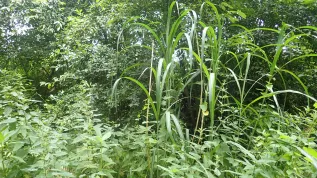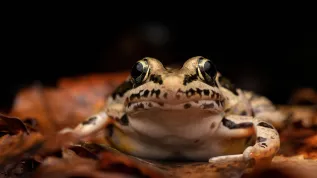
The plant can survive a drought because they have mechanisms of activation of genes needed to overcome the difficult conditions. Every living organism regulates the activity of selected genes in individual cells. These processes involve histones - the proteins, on which the double DNA strand is wound. If scientists learned how they function, in future they could use this knowledge to create anti-cancer therapies and in plant breeding.
Weronika Sura, a PhD at Adam Mickiewicz University in Poznań, decided to check how a specific histone variant H2A.Z functions. For this purpose, she conducted so-called drought experiments, in which she limited watering model plant: thale cress. Model plant is a specific organism used by many researchers, which allows to compare the results of all the experiments. The research was worth the plant sacrifice - it turns out that H2A.Z is a very interesting protein.
"Each organism has a set of genes needed for normal functioning. But plants that can not escape from dangerous environmental conditions, have to adapt to them. Under the stress of drought, despite the lack of water, plant will try to function as long as possible. It produces a proteins that cope with osmotic stress. To that end, it alters the activity of many genes, and the genes that are not necessary for survival are silenced" - explained Weronika Sura.
Together with the research group of Prof. Jan Sadowski, the PhD student performed the whole genome analysis, which means that she investigated more than 20 thousand genes of the plant. She performed drought experiments, and the repeatability of results was controlled by measuring the water content in plants. Changes in gene activity were compared with the data on the presence of protein H2A.Z. It turned out the histone variant H2A.Z is removed during activation of genes. There is much more of it in the case of genes that - after activation of a factor - strongly alter their activity. This, in turn, may mean that the protein most likely has regulatory properties, and helps adjust the level of activity of certain genes in stressful situations.
Weronika Sura investigated the role of histone variant H2A.Z in regulating the activity of genes in a model plant, thale cress, as part of the Diamond Grant of the Ministry of Science and Higher Education. She continues her work as the head of her second grant, Prelude, awarded by the National Science Centre. In an interview with PAP she revealed the origins and details of research conducted for her doctorate.
"After the discovery of the structure of DNA that encodes genetic information, genome sequencing technologies took off. At first it was thought that how your body looks and works, depends on the realization of genetic information - what is contained in the DNA, plus the impact of the environment . Later it turned out that there is another level of regulation of gene activity: epigenetic mechanisms "- said the researcher.
Weronika Sura noted that genetic information is the same in each cell, but the cells are still different from each other (for example those in different tissues and organs). Thus, it is impossible that in every cell all the genetic information is used in the same way. Some genes are active only in certain cells, for example the eye or the liver. Also, at various stages of development of the organism certain genes must be switched on, others - off.
"We can imagine that in our foetal stage we needed the genes necessary for the development of fingers. When the fingers developed, genes needed for that had to be switched off. The entire genetic information is regulated in the same way - and more specifically the way in which genetic information is transcribed to proteins that build us. Not only the genome controls it, but also epigenetic mechanisms" - the researcher explained.
DNA in cells is packed and closely interacts with proteins - histones. These are proteins on which the double strand of DNA is wound. Interestingly, if someone were to unwind the entire DNA from one cell, the thread would have a length of 2 meters. However, these "spools", which are histones, also have a very important role in regulating gene activity.
"Histones affect whether the DNA is exposed or covered for factors that transcribe genetic information, thus leading to gene activity. Chromatin, or DNA complex with proteins, may be in a loose, accessible form, or condensed form - inaccessible for this transcription. Inaccessible areas are a record of the genes with low activity - and vice versa" - explained Weronika Sura.
She added that histones are subject to various modifications, or attaching various chemical groups. Histone code, or attachment of certain chemical groups to specific places in histones - correlates with higher or lower activity of genes. There is also a histone called H2A. Histone variant H2A.Z is a protein that can substitute H2A, but has different physicochemical properties.
Both mutations in genes, as well as epigenetic changes, can lead to diseases. Researchers have found that in certain types of tumours, such as breast cancer, the levels of histone H2A.Z are disturbed. For now, however, they are looking for information on the level of basic science, on what this relationship is in general.
It appears that H2A.Z occurs in all organisms containing nucleus - humans, animals, plants and less complex organisms. Without it we would not develop and live. In addition, this protein has changed very little in the course of evolution. H2A.Z variant in plants is very similar to the human H2A.Z. Therefore, the conclusions from model plant studies apply not only to other plants, but they may be true for the entire living world - at least at the level of epigenetics.
PAP - Science and Scholarship in Poland, Karolina Duszczyk
kol/ zan/ mrt/
tr. RL













